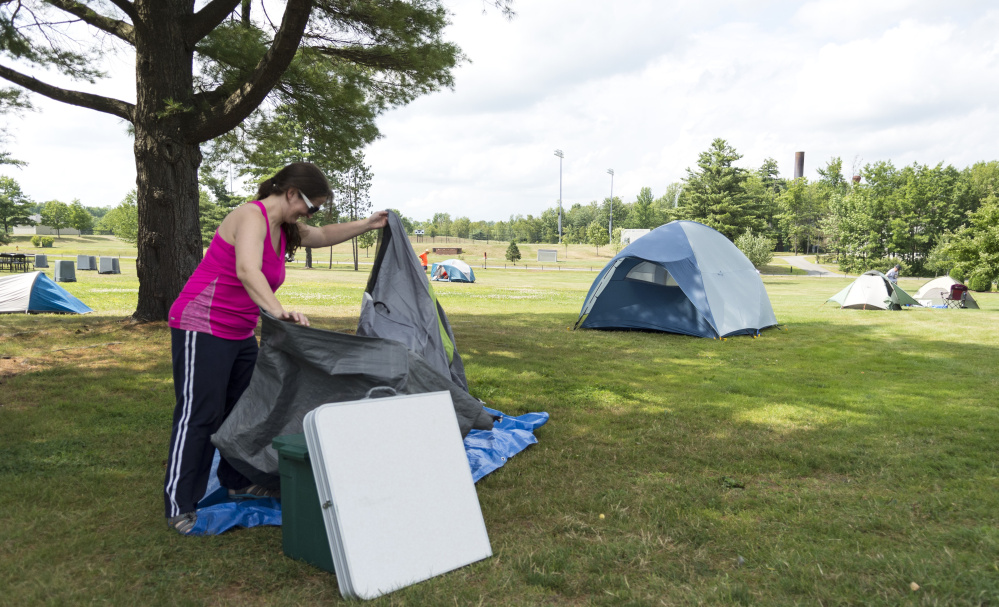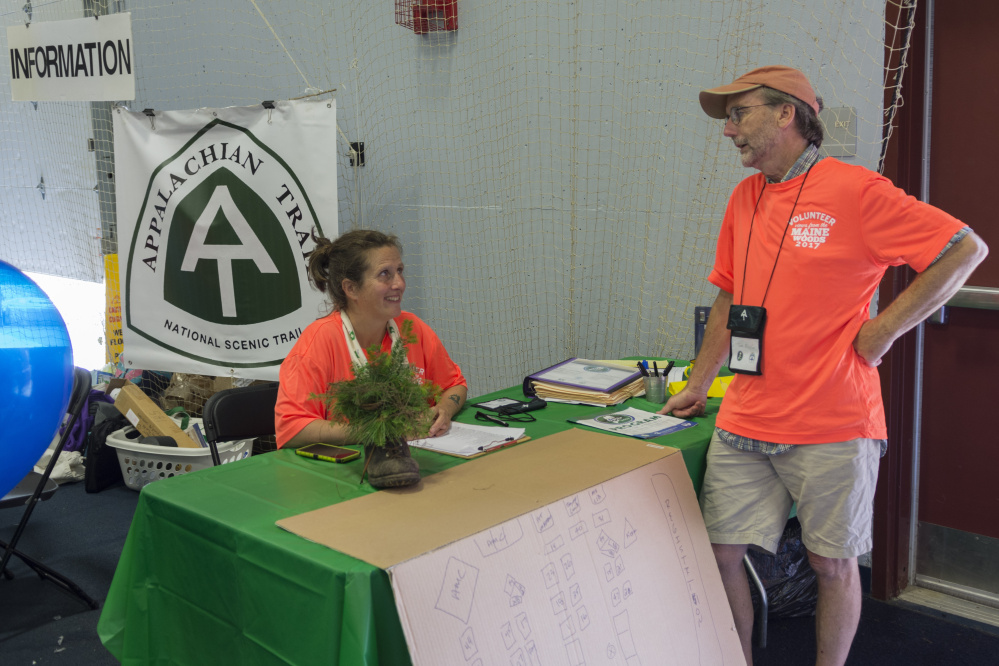WATERVILLE — At the Appalachian Trail Conservancy Conference meeting at Colby College, hikers have a way to “get there from here,” and “there” stretches from the highest coastal mountains on the Eastern Seaboard to exposed ridges on western Maine peaks that provide panoramas of the most heavily forested state in the nation.
Billed as “Views from the Maine Woods,” the conference offers participants more than 240 hiking opportunities, from those close at hand, such as the Kennebec Highlands in Vienna, Rome, Mount Vernon and New Sharon, to backpacking on trails deep in the Maine wilderness and up Saddleback and Sugarloaf mountains.
Co-hosted by the Maine Appalachian Trail Club and the Maine Chapter of the Appalachian Mountain Club, the national Appalachian Trail Conservancy Conference, which started Friday and runs until Aug. 11, last came to Maine in 1997. The event includes workshops, guided hikes, outdoor activities and guest speakers and brings together more than 1,000 participants from around the United States and Canada.
But the real star of the event is the iconic Appalachian Trail itself and its 267 miles through tough Maine wilderness.
The final mile of Maine’s section of the Appalachian Trail was completed in 1937; and over the last couple of decades, much work has been done to preserve the land the trail crosses.
LAND PROTECTION SUCCESS
At the time the Maine Appalachian Trail Land Trust was formed in 2002, Simon Rucker, executive director of the trust, said there was a push in the trail community to protect the Maine section of the trail as a resource in itself. The trail corridor contains a lot of timberland and working forest, and compared to other states with sections of the trail, Rucker said, Maine had less federal or state protected land, which left land vulnerable to development.
“Our mission is to conserve and protect land along the Appalachian Trial,” Rucker said.
Since 2002, the land trust has thrived, while others along the rest of the Appalachian Trail haven’t succeeded, Rucker said. The trust’s first project targeted Mount Abram in Franklin County in 2004, which is now state land, and Rucker will be leading a hike there Monday. Among other projects, the trust has done conservation work at Saddleback Mountain on the side opposite the ski area.
“The projects are for public benefit,” Rucker said. “It’s not just hiking. It’s all kinds of recreation.”
There is still a lot going on, even if the landscape has changed in the last 20 years, Rucker said. Since 1997, much more land has been conserved, and Rucker thinks people now see the Appalachian Trail as a resource, and that preserving and protecting land along the trail benefits Maine. It can be used for more than just hiking as well, he said, listing activities such as hunting, fishing and riding all-terrain vehicles.
“There’s a lot of stuff going on in this region,” Rucker said. “It’s a bright future for the region.”
In 1992, five years before the last Maine conference, an inventory revealed a 43-year backlog of repair that needed to be done on the Maine section of the trail, according to Lester Kenway, president of the Maine Appalachian Trail Club. Five years ago, another inventory was done, indicating a 23-year backlog still existed. The numbers reflect the number of “crew weeks” needed to complete a project, Kenway said, and a crew involves six people each working 40 hours a week, including travel and hike time.
Since 1992, much has been accomplished. Kenway, the trail supervisor at Baxter State Park from 1978 to 2000 and program coordinator for the Maine Conservation Corps from 2001 to 2008, leads the conservation work performed by MATC. The Maine club has completed about $1 million worth of trail work, he said.
The crews are a mix of employees and volunteers. Maine’s 267 miles of Appalachian Trail are broken up into 115 sections maintained by individuals or groups of people. A Maine trail crew has a leader and an assistant leader, who are paid employees with the Maine Appalachian Trail Club. Kenway said a crew also usually will have one intern, and then the rest of the crew is made up of volunteers.
“They come from all over the world,” Kenway said, listing Great Britain, France, Belgium and Russia as the home countries of recent volunteers.
LANDMARK PROJECTS
Kenway expanded on some of the larger projects the club has completed, including building what he believes to be the largest stone staircase in Maine. A steep stretch of trail less than a mile long on the 3,655-foot White Cap Mountain in Piscataquis County was eroding into a ditch. Because of the high elevation, the soil would change because of pressure. It would liquefy when pressure intensified and then solidify once the pressure was released.
“We rebuilt that trail,” Kenway said, estimating more than 850 stone steps were installed. The project took 23 years to finish.
“That’s a landmark project,” he said.
Another landmark project was created in the Kennebec area of the trail, Kenway said. The trail goes through a swampy, marshlike area. The traditional solution to marsh problems calls for spanning the area with a bridge. However, the Kennebec area was home to beavers, Kenway said, and their dams caused water levels to rise and fall, altering accessibility to the path. So a new bridge system was developed, Kenway said, with posts stuck down into the mud to create elevated bog bridges. Three of these were made, Kenway said – one that was 320 feet, a second that was 200 feet, and a third at 170 feet. While labor-intensive, they have worked out well.
“That method is proving to be a good one,” Kenway said.
Repairing trails that had been damaged by running water is a third key project, Kenway said. Rock water bars, a kind of trench that doesn’t wash out, have been built to divert water. Kenway said the system works similarly to how culverts work.
About 800 of these have been put in, he said, which not only preserves the trails but also helps the larger ecosystem. When trails get washed out, the silt from the soil makes its way into the water source, which damages the ecology of the lake.
“By diverting water frequently, we pretty much eliminate that,” he said.
Kenway, who consults for trail system maintainers across the country, will present a program at the conference on trail restructuring and rebuilding.
The conference, he said, “gives the Maine Appalachian Trail Club good exposure.”
TRAIL TEACHING
Education is a major aspect of keeping the trails and the surrounding landscape in good condition, and it provides hikers with the knowledge of how to leave no trace on the trails. MATC’s Caretaker & Ridgerunner Education Program provides the knowhow and is affiliated with the national Leave No Trace program that teaches backcountry knowhow, skills and ethics.
Holly Sheehan, who manages the MATC program, said Caretakers and Ridgerunners not only educates hikers and campers on how to leave no trace behind, the proper ways to use an open fire and how to remain considerate of other visitors; they are also available in case of a medical emergency on the trail, in which case they provide valuable assistance, since they know the trails. Ridgerunners also do light maintenance and work with new hikers carrying too much.
Ridgerunners hike different sections of the trail and can be found at Horns Pond in the Bigelow Preserve, Piazza Rock near Saddleback Mountain, Gulf Hagas near Greenville and Abol Bridge at the border of Baxter State Park and the 100 Mile Wilderness, which starts in Monson.
“They’re out there now,” Sheehan said. “They’re out there from May to October. They live there on the trail and they work there.”
Since education is such a key part of maintaining the trails, the Colby conference is a good way for the trail community to get together and share ideas, Sheehan said.
“I think it really highlights Maine and the amazing trails we have, the natural beauty, and it’s an opportunity to get people together that feel strongly about protecting the outdoors,” she said.
Colin Ellis can be contacted at 861-9253 or:
cellis@centralmaine.com
Twitter: @colinoellis
Send questions/comments to the editors.




